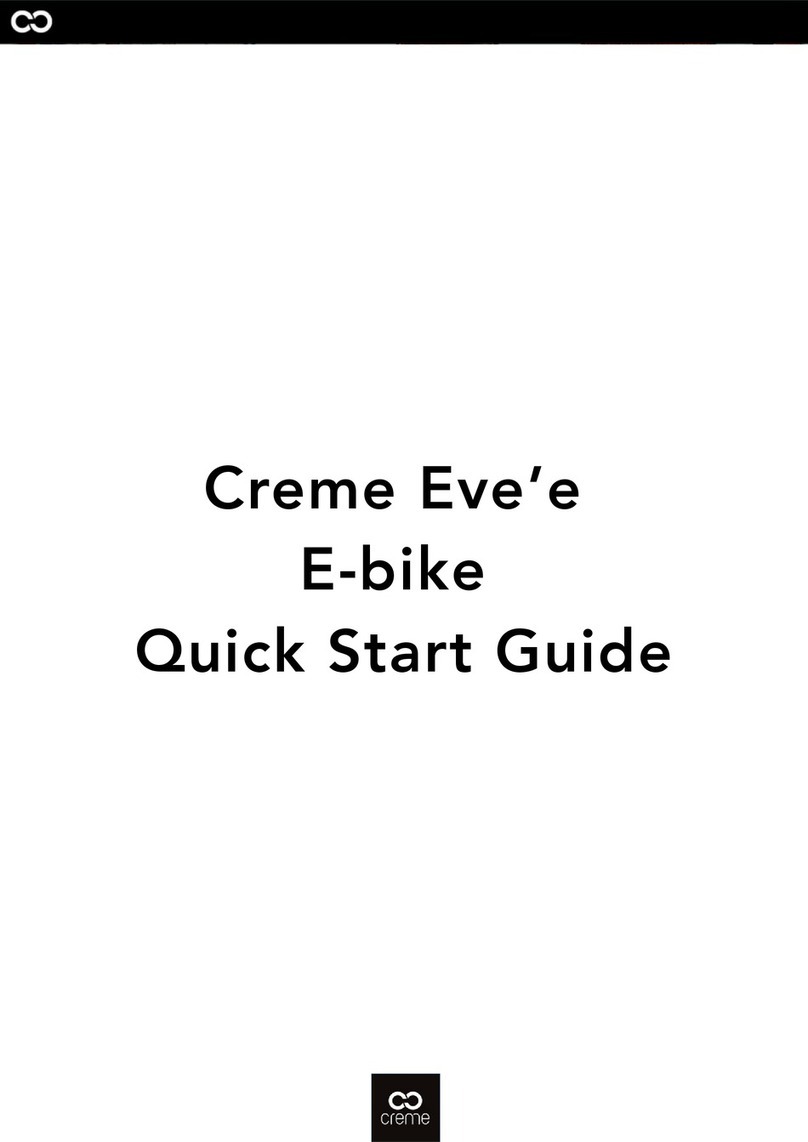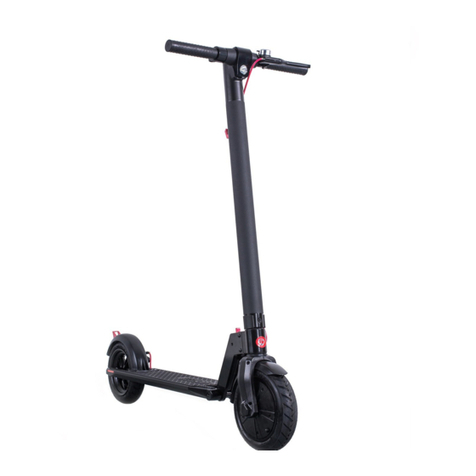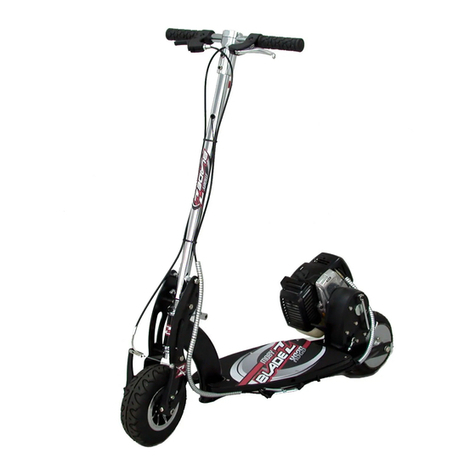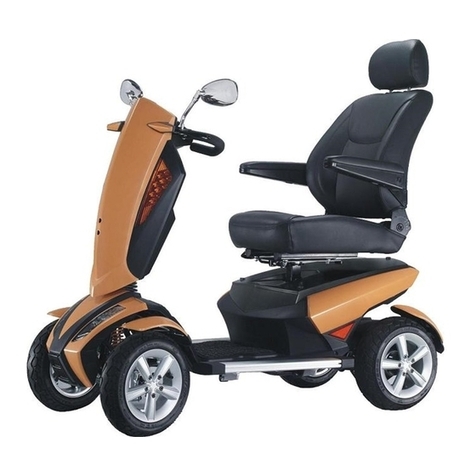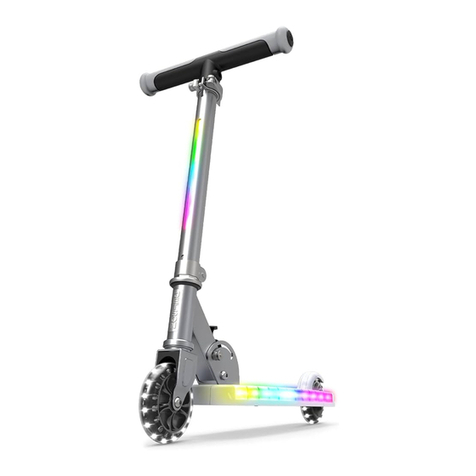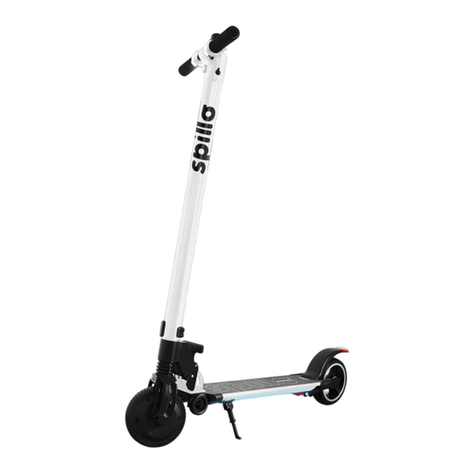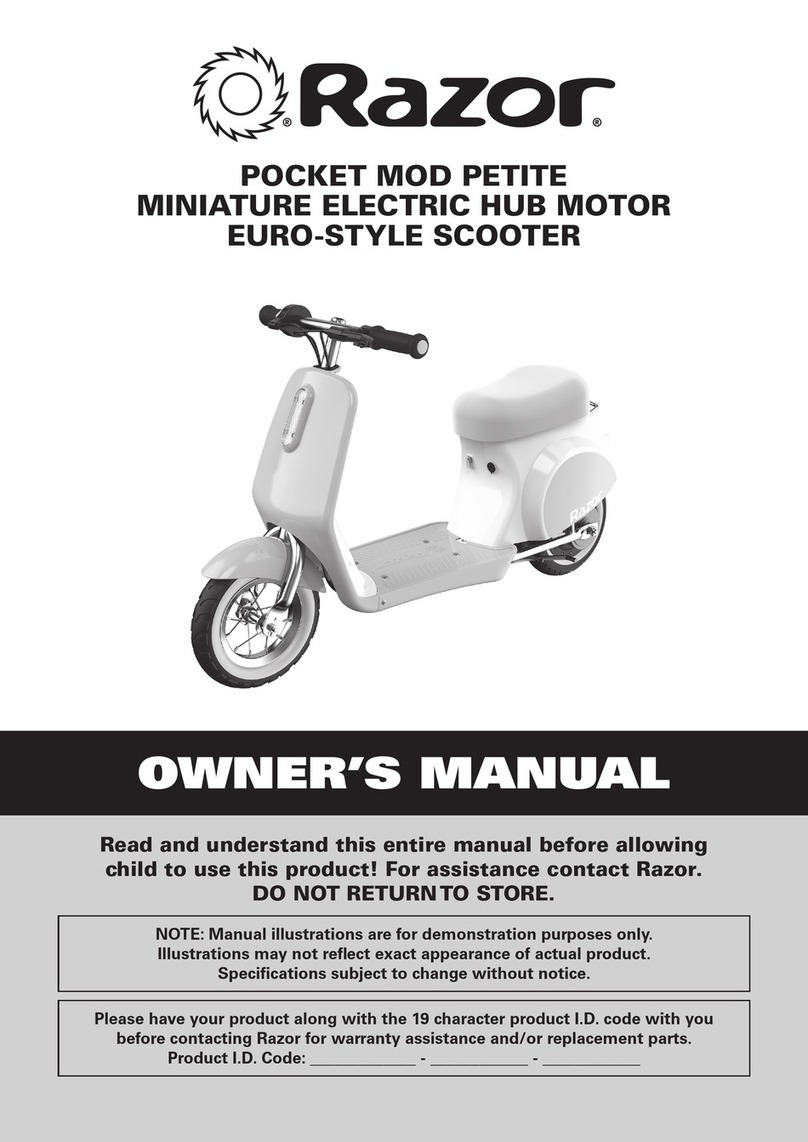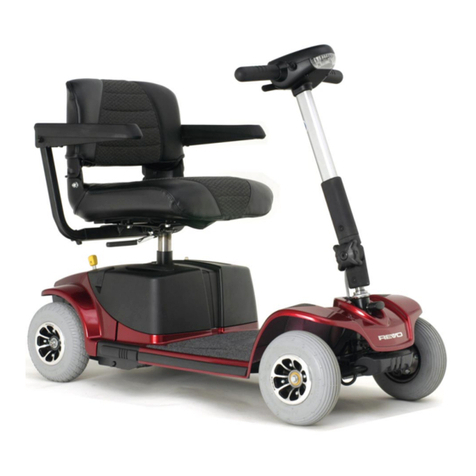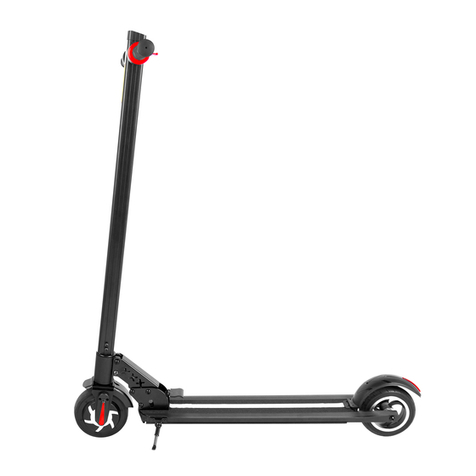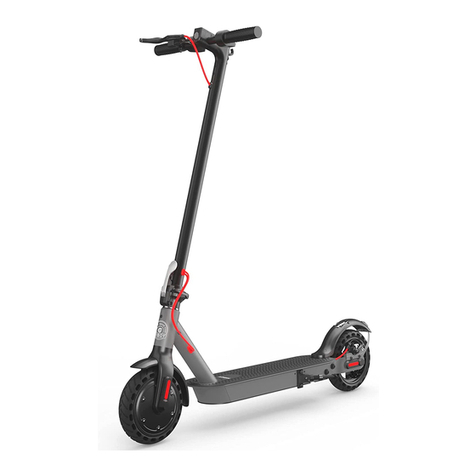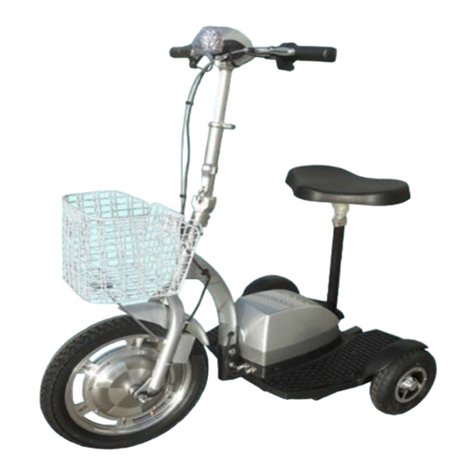Creme Ristretto ON+ Solo 2019 Guide


2
TABLE OF CONTENTS
WARNINGS AND IMPORTANT INFORMATION ������������������������������������������������������������������������������������� 2
INTRODUCTION ���������������������������������������������������������������������������������������������������������������������������������������������������������� 4
SPECIAL NOTE FOR PARENTS ��������������������������������������������������������������������������������������������������������������������������� 4
SPECIAL NOTE FOR E-BIKES ������������������������������������������������������������������������������������������������������������������������������ 5
ASSEMBLY OF THE NEW BICYCLE ����������������������������������������������������������������������������������������������������������������� 7
GENERAL RIDING INFORMATION ������������������������������������������������������������������������������������������������������������������ 7
PRE-RIDE CHECK ����������������������������������������������������������������������������������������������������������������������������������������������������� 13
ADJUSTMENTS ��������������������������������������������������������������������������������������������������������������������������������������������������������� 18
MAINTENANCE AND PERIODICAL CHECKS ���������������������������������������������������������������������������������������� 21
IMPORTANT SAFETY INFORMATION FOR ASSEMBLY AND USE OF FRONT
CAFERACER CARRIER ������������������������������������������������������������������������������������������������������������������������������������������ 25
Please read this manual carefully. It contains important safety
and service information !
WARNINGS AND IMPORTANT INFORMATION
WARNING: If you intend to use the bicycle on public roads, you must prepare it
to meet the local requirements for items such as lights and reectors because
your bicycle may not be prepared for riding on public roads in your country. Al-
ways follow all local trac laws and regulations in force on public roads as well
as o-road, including regulations about bicycle lighting, reectors, licensing of
bicycles, riding on sidewalks, laws regulating bike path and trail use, helmet
laws, child carrier laws and other special bicycle trac laws.
WARNING: Some of the service procedures require specialist tools and good
mechanical skills. Therefore, to minimise the risk of serious or even fatal acci-
dents, maintenance and assembly work on your bicycle should be carried out
by an authorised bicycle workshop.
IMPORTANT NOTICE: This manual is not intended as a comprehensive use, service, re-
pair or maintenance manual� Please consult your dealer for advice and your dealer may
also be able to refer you to classes, clinics or books on bicycle use, service, repair or
maintenance�
WARNING: The bicycle box contains instructions for components made by third
parties. You must study these carefully and follow the directions before riding
your bicycle.
INFORMATION: The maximum load on the front rack (or basket) is 8 kg� The maximum
load for the rear rack is 20 kg (unless otherwise stated on the rack)� Note that mount-

3
ing heavy objects on racks, especially on the front, will significantly change the steering
characteristics of your bike� It is advised to take some time to get used to the bike with
a loaded rack by riding it first on a side road or empty parking lot before going on the
street� Always make sure that your luggage is properly fastened to the rack!
INFORMATION: The maximum total permissible weight allowed (bike + rider + clothing
+ protective gear + backpack, luggage etc�) is 130 kg�
WARNING: Never carry anything which obstructs your vision or your complete control
of the bicycle, or which could become entangled in the moving parts of the bicycle.
INFORMATION: The bicycle you have just purchased is designed for riding on a paved
surface where the tires do not lose ground contact� Using the bicycle in off-road con-
ditions may lead to severe damage to some of the parts and may lead to serious ac-
cidents�
WARNING: The stem’s minimum insertion mark must not be visible above the
top of the headset. If the stem is extended beyond the minimum insertion mark
the whole steering system may fail and cause you to lose control of the bicycle.
This may result in injury and death.
WARNING: Do not extend the seat post above the minimum insertion mark.
WARNING: Alloy handlebars should be replaced at least once a year because
they can snap suddenly with no warning if submitted to fatigue stress for a pro-
longed period of time.
WARNING: The transport of children and luggage is associated with certain
risks. Not all frames are compatible with all third party bicycle racks or child
seats. Please consult a specialist dealer on this matter.
WARNING: The fitting and use of bicycle trailers on our bicycles is not allowed,
provided they have not been specically approved for the respective bicycle
model.
WARNING: As with all mechanical components, the bicycle is subjected to wear
and high stresses. Dierent materials and components may react to wear or
stress fatigue in dierent ways. If the design life of a component has been ex-
ceeded, it may suddenly fail possibly causing injuries to the rider. Any form of
crack, scratches or change of colour in highly stressed areas indicate that the life
of the component has been reached and it should be replaced. When replacing
any components, especially the safety-critical ones, genuine spare parts com-
plying with your bicycle’s specifications are to be used only. The manual pro-
vided by the part manufacturer contains full details. Please contact your dealer
if you have any doubts.

4
WARNING: It is crucial to apply correct tightening force on fasteners, nuts, bolts,
screws on your bicycle so as to avoid components failure or damage, which can
result in your losing control of the bicycle and falling. Using too little force may
result in the fastener not holding securely, moving and undergoing fatigue. Ap-
plying too much force may cause the fastener to strip threads, stretch, deform
or break. If you observe any problems at the pre-ride check, consult a profes-
sional bicycle mechanic instantly for advice. You can ride the bicycle again only
after the problem has been resolved.
INTRODUCTION
Congratulations on your purchase of one of the most stylish bicycles in the world� At
Creme, we are all very passionate about what we do, and seeing happy customers is the
biggest reward that we can get for working hard� So we do everything in our power to
make this happen, but even then, a bicycle that is not properly set up or maintained, will
be a disappointment� That is why it’s so important that you acquaint yourself with this
manual before your first ride�
Please pay special attention to the safety information� Riding a bicycle is potentially dan-
gerous, and this advice is important to help you avoid serious injury� If you have any
questions that cannot be answered by studying this manual, or find any problems with
your bicycle, please contact a good bike workshop for assistance� It will usually be the
best thing to do, and will not only save time but also ensure that your bicycle is properly
prepared for you, and what’s most important – safe�
Now, make yourself some tea or coffee, or crack open a beer (non alcoholic of course)
and read on���
SPECIAL NOTE FOR PARENTS
IMPORTANT NOTICE: As a parent or guardian, you are responsible for the safety of the
child under your supervision� This, among other things includes making sure that the
bicycle is properly fitted, adjusted, and that it is in good condition� Make sure that the
child’s bicycle is sized so that when the saddle is adjusted correctly, both feet can touch
the ground� Be sure that you and the child have learned and understand how to operate
the bicycle safely in the environment that you plan to ride�
WARNING: Make sure that your child always wears an approved bicycle helmet when
riding� At the same time, make sure that your child understands that a bicycle helmet
is to be used only on the bike, and must be removed when not riding� A helmet should
never be worn while playing, on playground equipment, while climbing trees, or at any
time while not riding a bicycle� Failure to follow this warning could result in serious injury
or death�

5
WARNING: If you intend to put a child seat on your bicycle, you will need to completely
enclose any coil springs under the saddle with a suitable covering to prevent the pinch-
ing or trapping of the child passenger’s fingers�
SPECIAL NOTE FOR E-BIKES
Electric bikes, also known as e-bikes or pedelecs are bicycles equipped with an electric
pedal assist drive system� An e-bike IS NOT a moped or motorcycle� The drive system
provides the power only while you are pedalling� The amount of power transferred by
the drive unit depends on the pedalling force and chosen assistance level� When you
stop pedalling, the drive system disengages� Also, in all assist levels, the drive system will
cut off as the bike reaches the maximum allowable speed of 25km/h� When the speed
drops below that, and the pedals are turning, the system will re-engage automatically�
WARNING: Do not modify the bicycle drive system/ in any way for any reason.
Doing so can result in severe damage, faulty or dangerous operating conditions,
or violation of local laws. Dealers and owners must not change, alter, or modify
in any way the original components of the bicycle or drive-assist system (e.g.
the specied sizing of the attached gear ratios (front/rear chain rings) ). Any
modications may make the bike dangerous to the rider and / or other road us-
ers. Use only specied manufacturer drive-assist service and replacement parts.
WARNING: Only use the battery pack and charger recommended by the drive
manufacturer Do not use other batteries or chargers. Do not use the charger to
charge other batteries.
IMPORTANT NOTICE: When the battery is not in use in the bicycle, its transportation
is subject to hazardous materials regulation� Special packaging and labelling require-
ments may exist� Contact local authorities for specific requirements� Never transport a
damaged battery� Insulate battery contacts before packaging� Package battery inside a
shipping container to prevent damage� The battery must be removed before flying� The
air carrier may request special handling of the battery�

6
TECHNICAL INFORMATION
Make yourself familiar with the names of all the main parts of the bike by studying the di-
agram below� Your actual model and the accessories (e�g� battery, lighting, fenders, rack,
kickstand) may be different to what is shown, depending on the type of bike you own�
1� Frame
2� Fork
3� Rim
4� Tire (with tube inside)
5� Hub
6� Handlebar
7� Headset
8� Stem
9� Pedals
10� Crankset
11� Chain
(or belt where applicable)
12� Seatpost
13� Seat binder
14� Saddle
15� Drive motor (if applicable)
16� Battery (if applicable)
17� Battery lock (if applicable)
18� Drive display/control unit (if
applicable)
19� Front chainring
20� Rear sprocket (or cassette)
21� Speed sensor (if applicable)
22� Rear Derailleur
23� Front derailleur
24� Brake lever
25� Disc brake
26� Roller brake
27� V-brake
28� Caliper brake
29� Head lamp
30� Rear lamp
31� Mudguard
32� Rack
33� Kickstand
34� Key
35� Control switch
(if applicable)
29
18
6
8
2
1
24
30
31
32
14
12
13
28
26
27
20
22
23
25
4
4
7
3
35
34
17
15
9
10
19
11
533 21
16

7
ASSEMBLY OF THE NEW BICYCLE
This should always be carried out by the dealer where you purchased your bicycle� If you
buy a bicycle that is disassembled, or only partially assembled, the warranty will be void�
Assembly should be done in your presence, in order to make the necessary adjustments
correctly, such as saddle height, handlebar angle and stem height� It is also important to
note that even if the bicycle is built up perfectly when new, it will need some additional
adjustments a few weeks (or around 50 km) later� You should visit your dealer and ask
him to check the bicycle for you after this period� This is essential to keep your warranty�
TOOLS REQUIRED: 4 mm, 5 mm, 6 mm, 8 mm allen keys, 8 mm, 10 mm, 13 mm, 15 mm
open end wrench, Torx 25 wrench, Philips head screwdriver, pliers with cable cutting
ability, torque wrench�
Correct frame size: To check if the frame size is safe, the rider should straddle the bicycle
while wearing the kind of shoes which will be used for riding and stand straight with feet
on the ground� The minimum distance between the rider’s crotch and top tube should
be 5 cm (approx� 2 inches)� This method of measuring the correct frame size does not
apply to bicycles with step-through frames, or so called “lady” frames� In case of these
frames, correct frame size should be determined first on a traditional diamond frame (so
called “men’s” frame)�
GENERAL RIDING INFORMATION
Riding a bicycle can be dangerous� You must keep this in mind and be cautious at all
times� Despite the fact that bicycles are usually slower than other motorised vehicles,
they can still be surprisingly fast especially on downhills and crashes can be just as seri-
ous as those experienced by users of cars and motorcycles�
Your first rides on the bicycle should start slowly in uncomplicated terrain so you can de-
velop your skills gradually� Even if you are an experienced cyclist, you will need to spend

8
some time getting used to any new bike� If you are a beginner, you should really commit
to mastering the skill of bike handling� Check out the response of your new bicycle as
well as the comfort in safe conditions, for example in an empty car park or side road�
Watch out for the brakes - they can be powerful and activating them too aggressively
can result in a crash� Learn to use them comfortably in all situations without loosing
control of the bicycle�
IMPORTANT NOTICE: On bicycles sold in UK, Japan, Australia and other left-hand drive
countries, the right lever should operate the front brake and left lever should operate
the rear brake� In countries with right-hand drive traffic systems, it will be the opposite�
However the user must check and make sure which lever is connected to which brake
before the first ride because it is possible that the bicycle was imported from a country
where brakes are set up differently to the standards applying in the country where the
bicycle will be used�
Practice taking corners at different speeds� Note that in some bicycle models the user’s
toe may touch the front wheel when a pedal is all the way forward and the wheel is
turned� This is normal, and your riding technique should take this into account (i�e� you
should not turn the handlebar sharply to the left when your right foot is in the most for-
ward position, or sharply to the right when your left foot is in the most forward position)�
If your bicycle is equipped with gears, practice choosing a gear combination that is most
comfortable for the riding conditions�
IMPORTANT NOTICE: Protect your bicycle against theft by purchasing a lock and never
leaving your bicycle unlocked while unattended, even if you are going to leave it only
for a short time�
IMPORTANT NOTICE: Wet weather conditions dramatically increase the risk of an acci-
dent as they impair traction, braking and visibility, both for the cyclist and for other road
users� It is more difficult to control your speed and you may lose control easily in such
conditions� To make sure that you are able to reduce speed and come to a stop safely in
wet conditions, try to ride more slowly and start braking earlier and more gradually than
you would under normal dry conditions�
IMPORTANT NOTICE: See and be seen� Use lights and reflective clothing in low light
conditions at all times� We strongly advise to always ride in a helmet�
IMPORTANT NOTICE: For longer trips, always carry spare clothes, and be prepared for
an unexpected change in the weather� Carry a pump, spare inner tube, patch kit, and a
basic tool kit� You may need this in case of a flat tire or other common mechanical prob-
lem that is usually easy to fix if you have the right tools� If you need to patch your inner
tubes, always make sure to follow the instruction manual provided by the tube repair kit
manufacturer�

9
WARNING: When your bicycle is on a bike stand or it’s upside down, never put
your finger or any other part of your body between the chain and the chain-
ring when the wheel is spinning. This is especially important on bicycles with
no derailleurs, because the chain is very tight. It is very easy to have your finger
crushed or even amputated in such a situation!
IMPORTANT NOTICE: Always conduct a pre-ride check (detailed information can be
found further in this manual)� Never ride the bicycle if you observe any technical prob-
lems or have any doubts about the proper functioning of any elements in the bicycle�
Keep the bicycle clean and well maintained�
IMPORTANT NOTICE: Make sure that your parts of the body and clothing as well as any
other objects do not touch the sharp teeth of the chainrings, chain wheels, sprockets,
chain, cranks, or spinning wheels of your bicycle�
IMPORTANT NOTICE: You shouldn’t ride your bicycle in remote areas unaccompanied�
Even when riding in the company of others, always let someone know where you’re go-
ing and when you expect to come back� Always keep some sort of identification with
you, so that you could be identified in case of an accident�
IMPORTANT NOTICE: In case of an accident or impact: first take care of your own situ-
ation - check yourself for injuries, and take the best possible care of them� Get medical
help if necessary� Then, check your bicycle for damage� After a crash of any kind, you
should have your bicycle thoroughly checked by your dealer� You must not use the car-
bon composite components, such as frames, wheels, handlebars, stems, cranksets, forks,
brakes, etc� which have sustained an impact until they have been disassembled and
thoroughly inspected by a qualified mechanic� The bicycle components can undergo
unusual stress due to a crash or impact of other kind, causing their premature fatigue�
Components suffering from stress fatigue can break suddenly and catastrophically,
which may result in your losing control, serious injury or death�
WARNING: Electric bikes are faster and heavier than conventional bicycles. Be-
cause of that, they require extra caution and care while riding. Failure to follow
safety instructions could lead to loss of control, a crash, injury or death. Make
sure you spend a sucient amount of time getting used to riding an e-bike in
the lowest assist mode before you speed up or start using it on public roads.
WARNING: Due to their weight, e-bikes take longer to slow down than conven-
tional bicycles. Remember to take this into account, especially in emergency
braking situations. It is advisable to stop pedalling earlier than on a normal bike
when coming up to a stop or when entering corners. Try to anticipate the ac-
tions of other road users. Do not ride in heavy gears especially with the system
in the high assist mode. This may prematurely damage the drivetrain and hub.

10
IMPORTANT NOTICE: The drive system on some e-bike models is turned ON and OFF
using a key� Keys may also operate accessories and locks, if equipped� Keys are identified
by the serial number� Please record the key serial number for future use and key replace-
ment� If your keys are ever lost or stolen, or you would like additional spares, please
contact the key provider� Don’t ride with key in battery lock� Always remove the key from
the lock after using it� Keys may be stolen or break off accidentally in the lock� Keep your
spare key in a safe place�
WARNING: When mounting your e-bike, make sure you do not step on the ped-
als until you are sitting on the saddle and griping the handlebars rmly. If you
apply pressure to the pedals and move them – the motor assist will switch on
and may result in uncontrolled start of your bike.
IMPORTANT NOTICE: The useful range of your e-bike depends on many factors� These
include the road conditions, the weight of the rider and any additional load, the rider’s
pedalling force, the level of assistance, the direction of the wind, the frequency of stops,
the temperature, weather conditions, the topography and the tyre pressure� To extend
the range it is recommended that you ride with low assistance or none at all on level
or downhill trails and only select maximum drive assistance when encountering head-
winds and steep climbs or when carrying heavy loads� Please refer to the system’s manu-
facturer manual how to check the level of battery�
Brake controls and features
There are three general types of bicycle brakes: rim brakes, which work by squeezing
the wheel rim between two brake pads; disc brakes, which work by squeezing a hub-
mounted disc between two brake pads; and internal hub brakes� All three can be oper-
ated by way of a handlebar mounted lever� On some bicycle models, the internal hub
brake is operated by pedalling backwards� This is called a Coaster Brake�
WARNING: Riding with brakes that have not been adjusted properly, worn brake
pads, or wheels with a visible rim wear constitutes a hazard and can cause seri-
ous injury or death. Too hard or too sudden application of the brakes can cause
the wheel to lock up and make you lose control and fall. Applying the front
brake too suddenly or excessively may result in the rider’s pitching over the
handlebars, potentially causing serious injury or death. Bicycle brakes may be
very powerful, especially disc brakes or linear-pull brakes. You should be extra
careful while learning how to operate such brakes and take particular care while
using them.

11
WARNING: Disc brakes can heat up extremely when their application is pro-
longed. Don’t touch a disc brake until it has had plenty of time to cool. Remem-
ber that brake pads in all brake types will wear out, which will ultimately reduce
their eciency.
For information on how to operate and maintain your brakes and when to replace the
brake pads see the brake manufacturer’s operation and maintenance manual� If you
have not been provided with the manufacturer’s instruction manual, contact your dealer
or the brake manufacturer� When replacing worn or damaged parts the manufacturer
approved genuine spare parts are to be used only�
WARNING: It’s vital for your safety to learn and remember which brake is con-
trolled by which brake lever on your bicycle.
Acquaint yourself with the setup of your brakes by alternately squeezing the left and
right brake lever and observing which brake lever activates the front brake, and which
one activates the rear brake� You should be able to reach the brake levers with your
hands and squeeze them easily� If you find out that your hands are too small to do so,
you should consult it with your dealer before riding the bicycle� In some models the
lever reach may be adjusted, or you may need a different brake lever design� On bicycles
with coaster brakes, the rear brake is controlled by the cranks, and there is usually one
lever on the handlebar which controls the front brake� The bicycle braking system’s func-
tion is based on friction between two braking surfaces� To assure its proper functioning,
you should maintain the rims, brake pads, disc rotors and calliper clean and free of dust,
dirt, grease, lubricants, waxes and polishes� There are special chemical cleaners avail-
able on the market designed specifically for cleaning these surfaces� Bicycle brakes have
been designed to control the speed of your bicycle by reducing it or preventing the
bicycle from moving� The maximum braking force for each wheel is achieved just before
the moment the wheel stops rotating (“locks up”) and starts skidding� The instant it has
begun to skid, the most of your bicycle’s stopping power and all directional control is
lost� Therefore, it is necessary to learn how to slow down your bicycle and bring it to a
halt smoothly avoiding a wheel lockup� Lever operated brakes are activated simply by
squeezing the levers on the handlebars� The more pressure you apply, the more force
will be applied to the wheels� Coaster brakes are activated by turning the cranks back-
wards� You need to start with the pedal cranks in a nearly horizontal position, with the
front pedal in the 4 o’clock position� You then need to apply downward foot pressure on
the pedal that is in the back� Activation of the brake will take place after approximately
1/8 rotation� The more downward pressure you apply, the more braking force, up to the
point where the rear wheel stops rotating and begins to skid� You should learn a progres-
sive brake modulation technique so that you are able to precisely and accurately control
the amount of braking force with given amount of input� Instead of applying the force
abruptly, it’s better to gradually increase the braking force� The instant the wheel begins

12
to lock up, slightly release pressure to keep it rotating� You should learn how much brake
pressure is needed for each wheel at different speeds and on different surfaces� Reduc-
ing the bicycle’s speed by applying one or both brakes will transfer the weight to the
front wheel as the rider’s body continues at the speed at which it was going� Heavy brak-
ing will result in the transfer of weight to the front wheel, which in extreme situations
may send the rider’s body flying over the handlebars� Greater brake pressure is needed
for a wheel burdened with a heavier load to lock up, whereas a wheel burdened with
less weight will lock up with less brake pressure applied� When the brakes are activated
you should move your body backwards in order to transfer weight to the back, simul-
taneously decreasing the rear braking force and increasing the front braking force� It is
especially important when you are descending� The weight transfer is more evident on
bicycles equipped with a front suspension fork as it dips under braking and thus inten-
sifies the weight transfer� To control your speed effectively and bring your bicycle to a
halt safely you need to be in control of the wheel lockup and the weight transfer� You
should practice braking and weight transfer techniques in safe places free from traffic
and distractions�
WARNING: Before riding, make sure that the brakes are working properly. If in
any doubt, have the bicycle checked by your dealer before you ride it.
Shifting gears
Shifting can be controlled by using various types of controls and methods: by using le-
vers, twist grips, triggers, combination shift-brake controls and push-buttons�Your dealer
should explain what type of shifting controls your bicycle has been equipped with, and
how they should be operated
IMPORTANT NOTICE: Never shift gears when pedalling in reverse, nor back pedal di-
rectly after the shifter has been moved� This could make the chain jam causing serious
damage to your bicycle�
We suggest you should find the gear relevant to your riding skills level� To do so check
which gear will be hard enough for you to accelerate quickly and yet at the same time
easy enough for you to be able to start your bicycle from a halt without wobbling� After
you have found your“starting gear”, go on to experiment with upshifting and downshift-
ing to learn how to operate different gear combinations� Different conditions require
different combinations, e�g� the combination of the largest rear and the smallest front
gears will work on the steepest hills, while the combination of the smallest rear and
the largest front gears will be used for reaching the greatest speed� Shifting gears in
sequence is not necessary� At first we suggest you practice shifting gears on a location
free from obstacles, hazards or other traffic, until you’ve built up your confidence� Learn
to anticipate the need to shift, and shift to a lower gear before the hill gets too steep�

13
Difficulties with shifting may indicate a mechanical adjustment problem, in which case
you should contact your dealer for help�
WARNING: If the derailleur does not shift smoothly, you should not shift fur-
ther, as it may be out of adjustment and the chain could jam, causing you to
lose control and fall. Failure to shift to the next gear smoothly after moving the
shift control by one click repeatedly indicates that the mechanism might be
incorrectly adjusted. You should have it checked by your dealer. If your bicy-
cle has been equipped with a single-speed drivetrain system, or internal gear
hub (hence has no external derailleur) the chain needs tension to make sure
it doesn’t come o the sprocket or chainring. Check tightness of chain & bolts
before every ride! The drive train is exposed to extreme loads. Any looseness or
play in drive train may cause damage to particular elements. Before each ride,
check: crankset, rear hub, cassette and freewheel, pedals and chainrings - crank
arm connection. The bicycle should be cleaned and lubricated with dedicated
grease systematically. Chain lubrication depends on weather and terrain condi-
tions. Water and mud speed up wear of the chain. Clean and lubricate chain
after each ride in wet or muddy conditions. The rear derailleur should shift
gears smoothly. You can adjust gear shifting through a rear shifter barrel or by
tensioning the cable under the cable anchor washer. Increasing the tension of
the cable facilitates shifting to a lower gear, decreasing the tension of the cable
facilitates shifting to a higher gear. Check if the pedals are properly threaded
into the cranks. Looseness may cause damage of crank thread. Regularly check
looseness in pedals to crankset connection.
A common mistake made by beginner cyclists is using a cadence that is too low� This is
usually even more prominent on e-bikes� A low cadence is bad for your knees, it’s inef-
ficient and will damage the bike over prolonged periods� You should always adjust the
gears so as to spin your legs freely, at around 80 revolutions per minute�
IMPORTANT NOTICE: On bicycles equipped with an external derailleur, it is not possible
to change the gears when standing still� Changing gears on such a bicycle requires the
user to pedal continuously until the new gear is engaged, and can be done without tak-
ing pressure off the pedals� On bicycles equipped with internal gears (hidden inside the
hub), it is possible to change gears without pedalling and also when pedalling, however
the rider must ease of the power prior to the gear change�
PRE-RIDE CHECK
IMPORTANT NOTICE: A pre-ride check should be made before every ride! This check
should include the following points:

14
Frame and fork structure
Clean the frame and fork and examine them CAREFULLY for any signs of cracks, corro-
sion, dents, paint peeling or other defects� If anything suspicious is found, contact your
local bicycle dealer for a proper inspection� These are important safety checks and very
important to help prevent accidents, injury and shortened product lifespan� Do not ride
the bicycle if you see any defects in the frame and fork�
Electric assist system
Inspect conditions of electric cables for any wear and interference with any of the bike
components� Test the drive assist system to make sure it works properly� Check if the bat-
tery is properly plugged-in and locked in place� Never set off with loose or unlocked bat-
tery� Do not use the e-bike without a battery� Remember to fully recharge the battery after
each longer ride (e�g� less than 50% charged)� Modern lithium batteries have no memory
effect� But it does not harm the battery if you put your pedelec away with the battery less
than 50% charged� However, you should not wait until the battery is fully discharged�
Please refer to the system manual of the drive manufacturer for more information�
WARNING: Always remove battery from the bike before working on the bicycle
or transporting it by car or plane. Accidental activation of the drive system may
result in serious injury.
Make sure that the control button on the control unit operate properly and display
shows all the values� Under no circumstances use the bike if the display shows any error
or warning messages� Please refer to the drive manufacturer manual for more informa-
tion�
Brakes
Check if the brakes are working properly by testing their efficiency in a parking lot or on
a side road� When the brake is applied with full force, the distance from the brake lever to
the handlebar should be bigger than 2 cm� Check the brake pads, too - you should replace
damaged and worn out elements and adjust them immediately when improper function
is noticed� To do this, contact your dealer or the closest authorised bike service� Remember
that improper setup of the brake can cause serious injury or death� Follow the brake manu-
facturer’s instructions closely for setup and maintenance� The instructions are supplied in
the box with every bicycle� If you are in doubt about their correct function, contact your lo-
cal bicycle shop� If your bicycle has rim brakes, inspect the rim walls to check if they are not
excessively worn out by the brakes� A groove made by the manufacturer on the sidewall
of a rim should always be visible� On rims without a groove/safety mark, it is important to
check if the braking surface has not become deformed by the brake pads� The rims should
be replaced as soon as a visible deformation of the rim surface occurs�
Cables
Check the brake cables and their housing for kinks, rust, broken strands, or frayed ends�
If you notice any damage, you should ask a bicycle shop to replace the cables immedi-

15
ately� If your bicycle has hydraulic disc brakes, check if brake fluid is not leaking, especially
in the areas where the cables connect to the calliper or brake lever�
WARNING: Damaged cables can seriously impede braking eciency and cause
you to loose control and crash.
Steering system
The steering system includes: handle bar, stem, headset and fork� All elements should be
connected firmly for riding safety�
WARNING: Proper assembly and functioning of the steering system is critical for
your safety!!!
Your dealer is responsible for proper assembly of the steering system for you� If you wish
to make any adjustments yourself, be warned that incorrect setup can be very danger-
ous and we always advise you to seek professional advice for this! Check the connection
between the handlebars and stem� Try pushing the handlebars up and down - there
should be no movement between these two elements� All parts of the stem should
be regularly checked for damage or cracks� If you find anything suspicious, contact an
experienced bike mechanic immediately� A defective steering system can cause serious
injury or death
Wheels and tires
Check if the wheels are straight (lift the bicycle and spin each wheel - the rim should not
move more than around 1 mm to each side)� Check if all the spokes are tight by running
your hand around each wheel on both sides� Contact your bicycle dealer to resolve any
problems� Do not attempt to ride a bicycle with wheels that are not straight or with
spokes that are loose, as it is dangerous to your health and life� Check the rims for signs
of ware, especially on bicycles with rim brakes� A rim that has visible grooves on the side
in the area where the brake pads make contact may be dangerous and requires immedi-
ate replacement� Check if the tires are properly inflated (see the prints on the side walls
for instructions about the optimum pressure: usually 3�5 – 4�5 bar depending on tire size,
terrain and weather conditions)� Use a proper bicycle pump with a pressure gauge to
achieve the correct pressure� Check the overall conditions of the tires, if they are dam-
aged, torn or worn out you should replace them before riding� Using worn or damaged
tires is dangerous� Make sure tires are correctly inflated and are in good shape� Spin each
wheel slowly and look for cuts in the tread and sidewall� Replace damaged tires before
riding the bicycle�

16
Front fork connections
15
problems. Do not attempt to ride a bicycle with wheels that are not straight or with
spokes that are loose, as it is a dangerous to your health and life. Check if the tires are
properly inflated (see the prints on the side walls for instructions about the optimum
pressure: usually 3.5 – 4.5 bar depending on tire size, terrain and weather conditions).
Use a proper bicycle pump with a pressure gauge to achieve the correct pressure. Check
the overall conditions of the tires, if they are damaged, torn or worn out you should re-
place them before riding. Using worn or damaged tires is dangerous. Make sure tires are
correctly inflated and are in good shape. Spin each wheel slowly and look for cuts in the
tread and sidewall. Replace damaged tires before riding the bicycle.
Front fork connections
Things to check before each ride: a) Check wheel axle to fork connection, b) Check brake
clamp to fork connection, c) Check headset looseness, d) Check stem to handlebar con-
nection, e) Clean fork stanchion tubes, f) Check general fork condition (take special note
of any cracks or deformations). Do not ride if any defects noticed! For information about
servicing suspension forks mounted on the bicycle it is necessary to follow manufactur-
er’s instructions closely. The user manual for the suspension forks are supplied in the box
with every bicycle. Check wheel axle to fork connection - this is critical for your safety. If
you have axle nuts they should be tightened according to the manufacturer’s specifica-
tion. If you have a quick release make sure that it is set to the CLOSED position, and that
there is a significant amount of resistance when pushing the lever and that it is set to the
CLOSED position (FIG.1). The amount of resistance can be adjusted by turning the knob
on the opposite side of the lever when the lever is in the open position. Never leave the
quick release loose, and do not try to turn it like a screw.
FIG.1
Things to check before each ride: a) Check wheel axle to fork connection, b) Check brake
clamp to fork connection, c) Check headset looseness, d) Check stem to handlebar con-
nection, e) Clean fork stanchion tubes, f ) Check general fork condition (take special note
of any cracks or deformations)� Do not ride if any defects noticed! For information about
servicing suspension forks mounted on the bicycle it is necessary to follow the manu-
facturer’s instructions closely� The user manual for the suspension forks is supplied in
the box with every bicycle� Check wheel axle to fork connection - this is critical for your
safety� If you have axle nuts, they should be tightened according to the manufacturer’s
specifications� If you have a quick release, make sure that it is set to the CLOSED position,
that there is a significant amount of resistance when pushing the lever and that it is set
to the CLOSED position (FIG�1)� The amount of resistance can be adjusted by turning the
knob on the opposite side of the lever when the lever is in the OPEN position� Never
leave the quick release loose, and do not try to turn it like a screw�
IMPORTANT NOTICE: Some bicycles have secondary retention devices on the front
wheel, usually those secondary retention devices look like special washers with a hook�
These must be correctly installed to avoid the possibility of the front wheel disengaging
from the fork�
WARNING: It is especially important that bicycles with disc brakes and standard
fork-ends (where the slot in the fork points downwards and slightly rearwards)
must be operated with special safety washers in place. Bicycles with reversed
fork-ends can be used without the safety washers. Failing to use special safety
washers with standard fork-ends can lead to a serious accident in a situation
where the quick release is not properly fastened. The force from the disc brake
can eject the wheel from the fork.

17
Please refer to the diagram below in order to identify these terms:
16
Some bicycles have secondary retention devices on front wheel, usually those second-
ary retention devices look like special washers with a hook.
WARNING: all bicycles with disc brakes and standard fork-ends must be oper-
ated with special safety washers in place. Bicycles with reversed fork-ends can
be used without the safety washers. Failing to use special safety washers with
standard fork-ends can lead to a serious accident in a situation where the quick
release is not properly fastened. The force from the disc brake can eject the
wheel from the fork.
Please refer to the diagram below in order to identify these terms:
Standard
fork end
Reversed
fork end
Standard safety
washer
- must be
mounted on all
bikes without
disc brakes
Special safety washer
- must be mounted
on all bikes with disc
brakes, unless the fork
has reversed fork ends
Bicycles with standard fork ends (thus requiring special safety washers) are the following
models:
Tempo Doppio, model year 2013 and 2014, Ristretto Doppio, model year 2012, 2013 and
2014, Ristretto Solo, model year 2012 and 2013.
If your bicycle has disc brakes and standard fork ends, and for any reason does not have
special safety washers, please do not ride the bicycle and contact us immediately� Refer-
ence bolt tightening torque values (please always refer to the manufacturer’s instruction
manual first, the values shown below do not apply to ALL types of components that may
be mounted on the bicycle):

18
17
If your bicycle has disc brakes and standard fork ends, and for any reason does
not have special safety washers please do not ride the bicycle and contact us im-
mediately.
Reference bolt tightening torque values (please always refer to the manufacturer’s
instruction manual rst, the values shown below do not apply to ALL types of
components that may be mounted on the bicycle):
Bolt type: Tightening torque (N-m):
Stem steer tube bolt 16
Stem handlebar bolts 14
Front hub axle bolts 17 (for 10mm axle hubs)
Rear wheel bolts/nuts 35
Crank to bottom bracket bolts 40
Seat binder, Seat post clamp bolts M5 10
Seat binder, Seat post clamp bolts M6 12
Pedals 25
Brake calliper screws to frame and fork 10
Shifting lever, Brake lever 3
Disc brake screws to hub 6.0
Rear derailleur: main fixing bolt 10
Rear derailleur: cable fixing bolt 5
Bolts in seat post clamp: M5 15
M6 20
13mm or 14mm nut 25
mounting bolts that secure the rack to the fork 7
ADJUSTMENTS
It is possible to make some adjustments to your bicycle that will influence your riding
position. These adjustments can make a great difference to riding pleasure, speed and
safety. Unless you are a very competent cyclist and mechanic, do not attempt to execute
any of these adjustments yourself. Seek advice at your local bicycle shop. The basic ad-
justment points are listed below:
ADJUSTMENTS
It is possible to make some adjustments to your bicycle that will influence your riding
position� These adjustments can make a great difference to riding pleasure, speed and
safety� Unless you are a very competent cyclist and mechanic, do not attempt to execute
any of these adjustments yourself� Seek advice at your local bicycle shop� The basic ad-
justment points are listed below:

19
Adjusting handlebar height and angle
18
Handlebar height and angle.
Quill stem Threadless stem
Your bike is equipped either with a “threadless” stem, which clamps on to the top part
of the steerer tube, or with a “quill” stem, which clamps inside the steerer tube with an
expanding wedge. If your bike has a“threadless”stem your dealer may be able to change
handlebar height by moving height adjustment spacers from below the stem to above
the stem, or vice versa. You can also replace the stem with one that has different length
or rise. You can also adjust the angle of the handlebars. These adjustments should be
made by your dealer or by a professional bicycle mechanic. Do not attempt to do this
yourself, as it requires special knowledge. If your bike has a “quill” stem you can ask your
dealer to adjust the handlebar height by adjusting the level of insertion of the stem into
the fork. Note that a quill stem has will have a mark showing the “minimum insertion”or
“maximum extension”level. This mark must not be visible above the headset. With a“quill
stem”you can also ask your dealer to adjust the angle of the handlebars.
WARNING: A quill stem’s Minimum Insertion Mark (or Maximum Extension
Mark) must not be visible above the top of the headset. If the stem is extended
beyond the this mark, the stem may break or damage the fork’s steerer tube,
which could cause you to lose control and fall.
WARNING: On some bicycles, adjustments in the position of the steering system
can aect the tension of the brake cables. This can result in locking of the brakes
or can create excess cable slack which can make the brakes inoperable. There-
fore after each adjustment of the steering system, the brakes must be checked
before you ride the bicycle.
WARNING: Never extend the stem above the minimum insertion mark that can
be found on the lower part of the stem’s shaft!
Your bike is equipped either with a “threadless”stem, which clamps on to the top part of
the steerer tube, or with a “quill” stem, which clamps inside the steerer tube with an ex-
panding wedge� If your bike has a “threadless”stem, your dealer may be able to change
the handlebar height by moving height adjustment spacers from below the stem to
above the stem, or vice versa� You can also replace the stem with one that has differ-
ent length or rise� You can also adjust the angle of the handlebars� These adjustments
should be made by your dealer or by a professional bicycle mechanic� Do not attempt
to do this yourself, as it requires special knowledge� If your bike has a “quill”stem, you can
ask your dealer to adjust the handlebar height by adjusting the level of insertion of the
stem into the fork� Note that a quill stem has a mark showing the“minimum insertion”or
“maximum extension”level� This mark must not be visible above the headset� With a“quill
stem”, you can also ask your dealer to adjust the angle of the handlebars
WARNING: A quill stem’s Minimum Insertion Mark (or Maximum Extension ‘
Mark) must not be visible above the top of the headset. If the stem is extended
beyond this mark, the stem may break or damage the fork’s steerer tube, which
could cause you to lose control and fall.
WARNING: On some bicycles, adjustments in the position of the steering sys-
tem can aect the tension of the brake cables. This can result in locking of the
brakes or can create excess cable slack which can make the brakes inoperable.
Therefore after each adjustment of the steering system, the brakes must be
checked before you ride the bicycle.
WARNING: Never extend the stem above the minimum insertion mark that can
be found on the lower part of the stem’s shaft!

20
Adjusting saddle height
This should be carried out using a 5 mm hex wrench� Unscrew the seat binder bolt, set
the saddle at a certain height, then re-tighten the bolt and sit on the bicycle (FIG�2)�
Repeat until you find the best position� The tightening torque of the seat binder should
be around 12 Nm�
WARNING: Never extend the seat post above the minimum insertion mark that
can be found on the lower part of the seat post!
19
Adjusting saddle height.
This should be carried out using an 5 mm hex wrench. Unscrew the seat binder bolt,
set the saddle at a certain height, then re-tighten the bolt and sit on the bicycle (FIG.2).
Repeat until you find the best position. The tightening torque of the seat binder should
be around 12Nm.
WARNING: Never extend the seat post above the minimum insertion mark that
can be found on the lower part of the seat post!
Adjusting the rail saddle position.
This should be done using a 5mm or 6mm hex wrench. When you loosen this bolt(s), it is
possible to change the angle of the saddle and it’s fore and aft position (FIG.3). Try experi-
menting with various combinations. A general rule is that the saddle should be set more
or less in the central position, and should be tilted slightly to the rear (the nose should
be pointing up around 3 -5 degrees). This will put more body weight on the saddle and
take of some pressure from your hands. Tighten the bolts to the following torque: M5:
10Nm, M6: 12Nm.
FIG. 2 FIG. 3
MAINTENANCE AND PERIODICAL CHECKS
Take care of your bicycle, and you will enjoy it for a longer time. Also take some time to
periodically inspect the bicycle in more detail - this is important for your safety. Here is
some basic information. A good rust inhibitor should be applied to the inside of your
frame at least once a year. Regular cleaning will remove salt and other chemicals from
the surface of your bicycle minimising the likelihood of external corrosion. It is very im-
portant that paint chips and scratches get touched up as soon as possible with factory
touch-up paint or nail polish. Prior to painting, make sure that the surface is free of rust,
clean and dry. The frame does not require any lubrication with the exception of the in-
Adjusting saddle angle and position
This should be done using a 5 mm or 6 mm hex wrench� When you loosen this/(these)
bolt(s), it is possible to change the angle of the saddle and its fore and aft position (FIG�3)�
Try experimenting with various combinations� A general rule is that the saddle should
be set more or less in the central position, and should be tilted slightly to the rear (the
nose should be pointing up around 3 -5 degrees)� This will put more body weight on the
saddle and take off some pressure from your hands� Tighten the bolts to the following
torque: M5: 10 Nm, M 6: 12 Nm�
Control position adjustments
It is possible to adjust the angle and position of brakes and shift controls on the
handlebars� Ask your dealer to make the necessary adjustments for you� If you choose to
adjust the control lever angle on your own, be sure to re-tighten the clamp fasteners to
the recommended torque (see the manufacturer’s instruction manual)�
This manual suits for next models
2
Table of contents
Other Creme Scooter manuals
